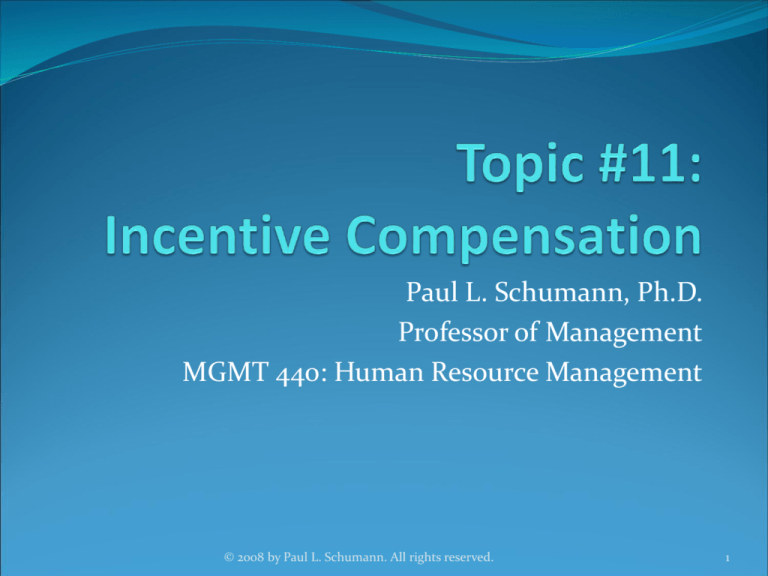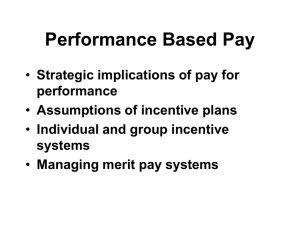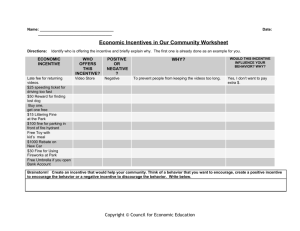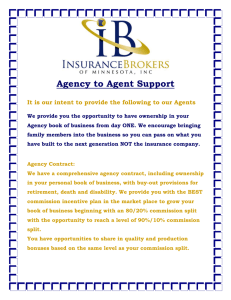
Paul L. Schumann, Ph.D.
Professor of Management
MGMT 440: Human Resource Management
© 2008 by Paul L. Schumann. All rights reserved.
1
Outline
What Is Incentive Pay?
Why Use Incentive Pay?
Does Incentive Pay Work?
Drawbacks of Incentive Pay
Incentive Pay Systems
Piece-Rate
Taylor Plan
Standard Hour Plan
Commissions
Merit Pay
Bonuses
Skill-Based Pay
Profit Sharing
Gain Sharing Plans
Employee Stock Ownership Plans (ESOPs)
Executive Compensation
2
What Is Incentive Pay?
Incentive pay links pay (as a reward) to performance
The idea of incentive pay is to create incentives for
employees to improve their job performance by linking
employee pay to employee job performance
Incentive pay is also called:
Pay for performance
Performance-based pay systems
Performance-based reward systems
The reward for performance doesn’t have to be pay
Pay is one possible reward, not the only possible reward
3
Why Use Incentive Pay?
We want to use pay (and other rewards) to align the goals
of each employee with the goals of the organization
This way, when employees work toward their own goals, they
are also working toward the organization’s goals
If incentive pay works to enhance employee motivation,
then the advantages include:
Increased employee productivity & job performance
Increased retention of high performers
Because high performers get more pay than low performers
Increased ability of the organization to achieve its objectives
Lower costs
4
Does Incentive Pay Work?
Expectancy theory gives us the answer:
Yes, incentive pay will motivate employees to improve
their job performance, but only if 3 conditions are
simultaneously satisfied:
High valence: employees must believe that the amount of the
reward (incentive pay) is large enough to be valued
High instrumentality: employees must believe that there is a
strong link between their job performance and their rewards
High expectancy: employees must believe that there is a
strong link between their effort and their job performance
Effort Performance Rewards
5
Does Incentive Pay Work?
Expectancy theory (more)
What can go wrong?
Effort Performance Rewards
Low valences: the reward (the amount of the incentive pay
increase) is too small to be valued
Example: Supervisor tells a salesperson “If you double your
sales from $1-million to $2-million, I’ll reward you with a pay
increase from $50,000 a year to $50,100 a year.”
Example: Suppose the budget allows for pay increases up to
4% when inflation is 3%: if all the employees get a 3% pay
increase (for inflation), then the employees with the best
job performance might only get an additional 1%
On a $50,000 salary, 1% is only $500 for exceptional performance
6
Does Incentive Pay Work?
Expectancy theory (more)
What can go wrong? (more)
Effort Performance Rewards
Poor instrumentality perceptions
Example: The supervisor gives everyone the same pay
increase regardless of differences in job performance
Example: The supervisor does a poor job of evaluating
employee job performance
Example: The supervisor plays favorites and gives the
biggest pay increase to the employee who is the supervisor’s
golfing buddy even though that employee has poor job
performance
7
Does Incentive Pay Work?
Expectancy theory (more)
What can go wrong? (more)
Effort Performance Rewards
Poor expectancy perceptions
Example: The employees believe that they are already
working as hard as they can
Example: The employees believe that there are barriers to
improved job performance that are outside of their control
8
Does Incentive Pay Work?
Expectancy theory (more)
Effort Performance Rewards
Summary: For incentive pay to work:
we need to make the incentive pay increase large enough that
employees want to put forth the effort to go after the incentive
and we need to show employees that there is a strong link
between their job performance and receiving the incentive pay
increase
and we need to show employees how, through their efforts,
that they can successfully improve their job performance
Put another way, employees need to believe: If they work at it,
they’ll achieve their goals, and they’ll get the promised reward
9
Drawbacks of Incentive Pay
Incentive pay is more work to administer
Across-the-board pay increases are easy to administer
We can make mistakes
Example: Link pay to the wrong measures of job performance
Example: Sears Auto Centers
Unions typically oppose many types of incentive pay
Fear of discrimination or favoritism by supervisors in job
performance evaluations, especially for subjective measures of job
performance
Unions prefer objective factors, such as across-the-board pay increases
or the use of seniority
Incentive pay creates competition among workers, which weakens
worker solidarity (solidarity is necessary for union success)
Unions might agree to group-based objective incentives
Example: Profit-sharing bonus
10
Incentive Pay Systems
Piece-rate: pay is a set amount per piece of production
Straight piece-rate: pay is entirely on a piece-rate basis
Example: Production job
Market pay = $12 per hour
Average hourly production target = 60 pieces per hour
Piece-rate = $12/60 = $0.20 per piece
50 pieces → 50 × $0.20 = $10.00 (below market pay)
60 pieces → 60 × $0.20 = $12.00 (market pay)
70 pieces → 70 × $0.20 = $14.00 (above market pay)
80 pieces → 80 × $0.20 = $16.00 (above market pay)
Base pay plus piece-rate
Example: Production job
$12 per hour plus $0.20 per piece for production over 60 pieces in an hour
70 pieces → $12 + [(70 − 60) × $0.20] = $12 + [10 × $0.20] = $14.00
11
Incentive Pay Systems
Taylor Plan: piece-rate with differential rates
Example: Production job with 2 piece rates
Production standard = 60 pieces per hour
Piece-rate #1 = $0.20 per piece if production is less than 125% of the
production standard (1.25 × 60 = 75 pieces per hour)
60 pieces → 60 × $0.20 = $12.00 (market pay)
70 pieces → 70 × $0.20 = $14.00
Piece-rate #2 = $0.25 per piece on production over 60 pieces if
production equals or exceeds 125% of the production standard (1.25 ×
60 = 75 pieces per hour)
80 pieces → (60 × $0.20) + [(80 − 60) × $0.25)] = $17.00
Recall the straight piece-rate ($0.20) paid $16 for 80 pieces
Note this makes the reward for exceeding 75 pieces bigger
(increased valence), which strengthens the motivational force
12
Incentive Pay Systems
Standard hour plan: piece-rate where the standard is set in
terms of time (instead of units produced)
Method:
For a job title, make a list of possible tasks
For each task, establish a standard length of time that it should take
to complete the task
Base pay on the standard times, not actual clock times
Example: Auto mechanic
Market pay = $20 per hour
Task: balance & rotate 4 tires
Standard = 30 minutes = 0.50 hours
Pay for task = $20 per hour × 0.50 hours = $10.00 (no matter how
long it actually takes the mechanic to do the task)
Mechanic takes 15 minutes or 60 minutes → Pay = $10
13
Incentive Pay Systems
Sales commissions: salesperson’s pay is a percentage of
his or her sales
Straight commission: pay is entirely on commission
Example:
Market pay = $50,000
Sales target = $1,000,000
Commission rate = 50,000/1,000,000 = 0.05 = 5.0%
Sells $900,000 → Pay = $45,000 (below market)
Sells $1,000,000 → Pay = $50,000 (market)
Sells $1,000,000 → Pay = $55,000 (above market)
Base pay plus commission
14
Incentive Pay Systems
Merit pay: the employee’s annual pay increase is based on
the employee’s job performance in the previous year
We evaluate the employee’s job performance by using the
organization’s performance appraisal system
Measure the relevant results & behaviors of the employee
Objective measures of employee job performance: production
measures, sales measures, personnel data, performance tests,
business unit performance measures
Subjective measures of employee job performance: rating scales to
subjectively measure multiple aspects of job performance
Management By Objectives (MBO)
We use our evaluation of the employee’s job performance to
decide his or her annual pay increase
15
Incentive Pay Systems
Merit pay (more)
Example: Company uses the following 5-point rating scale to
evaluate the employee’s overall job performance and to award
the corresponding annual merit pay increase:
5 = Excellent
= 4.0% pay increase
4 = Very Satisfactory = 3.0% pay increase
3 = Satisfactory
= 2.0% pay increase
2 = Unsatisfactory
= no pay increase
1 = Very unsatisfactory = no pay increase
Merit pay might be combined with a forced distribution
Merit pay is widely used in the US
Merit pay is used at all organizational levels
16
Incentive Pay Systems
Merit pay (more)
Potential difficulties of merit pay
Supervisors can make mistakes in evaluating employee job
performance & in assigning merit pay increases
The mistakes weaken the instrumentality perceptions
Effort Performance Rewards
Reduces the motivational effectiveness of the incentive pay
system
The mistakes create perceptions of inequity (unfairness)
If employees feel underpaid, they may reduce their
contributions (reduce their effort)
17
Incentive Pay Systems
Merit pay (more)
Potential difficulties of merit pay (more)
The annual merit pay increase can come months after specific
instances of good performance
Rewards are more effective when they are received
immediately after the desired behavior or result
The delay in receiving the reward will weaken the
employees’ instrumentality perceptions
Effort Performance Rewards
Reduces the motivational effectiveness of the incentive pay
system
18
Incentive Pay Systems
Merit pay (more)
Potential difficulties of merit pay (more)
Differences in merit pay increases may be too small to be meaningful
Example: Current pay = $50,000; Suppose:
Top performers: 4% merit increase → $2,000 pay increase
Middle performers: 2% merit increase → $1,000 pay increase
Some middle performers may believe that the extra $1,000 per
year isn’t worth the extra effort required to become a top
performer
At 2,000 annual work hours, the $1,000 difference works out to an
extra $0.50 per hour when they’re making over $25 per hour
Result is low valences
Effort Performance Rewards
Reduces the motivational effectiveness of the incentive pay
system
19
Incentive Pay Systems
Merit pay (more)
Potential difficulties of merit pay (more)
Merit pay budgets can vary from year to year
Result is that the same job performance may get different
rewards depending on whether it’s a good year or a bad year
If the same job performance is rewarded differently from
one year to another, then:
It weakens the instrumentality perceptions
Effort Performance Rewards
Reduces the motivational effectiveness of the incentive pay system
It create perceptions of inequity (unfairness)
If good-performing employees feel under-rewarded in the bad years
when merit pay increases are smaller, then employees may reduce
their contributions (reduce their effort), especially in the bad years
20
Incentive Pay Systems
Merit pay (more)
Potential difficulties of merit pay (more)
Merit pay increases become part of the employee’s base pay in future years, even if
the employee’s job performance isn’t so good in the future years
We end up continuing to reward the employee in the future for job
performance that might have been years in the past
Example:
2005 → new hire → pay = $50,000 → at end of 2005, performance rating = 5 →
merit pay increase = 4% ($2,000)
2006 → pay = $52,000 → at end of 2006, performance rating = 3 → merit pay
increase = 2% ($1,040)
2007 → pay = $53,040 → at end of 2007, performance rating = 1 → no merit pay
increase
2008 → pay = $53,040 → the employee is still being rewarded in 2008 (and
beyond) for performance in 2005 & 2006
This weakens the instrumentality perceptions
Effort Performance Rewards
Reduces the motivational effectiveness of the incentive pay system
21
Incentive Pay Systems
Bonus: employee receives a one-time lump-sum payment for meeting a
performance goal
Performance goal might be:
Individual employee’s performance goal
Example: Salesperson’s goal is to achieve at least $2-million in sales
Organization’s performance goal
Example: Company’s goal is to achieve earnings-per-share of at least $3.15
The bonus amount does not become part of the employee’s base pay
Example:
2005 → new hire → pay = $50,000 → at end of 2005, performance rating = 5 → bonus =
$2,000 → total pay = $52,000
2006 → pay = $50,000 → at end of 2006, performance rating = 3 → bonus = $1,000 →
total pay = $51,000
2007 → pay = $50,000 → at end of 2007, performance rating = 1 → bonus = $0 → total pay
= $50,000
2008 → pay = $50,000
This strengthens the instrumentality perceptions
Effort Performance Rewards
Increases the motivational effectiveness of the incentive pay system
22
Incentive Pay Systems
Skill-based pay (pay-for-knowledge): pay is based on work-
related skills, not seniority or job performance
Example:
New hire receives initial training to perform the entry-level job and
is paid at the entry-level rate
As the employee completes training and becomes qualified to
perform additional jobs, the employee is rewarded with pay
increases
The employee is typically paid at the pay rate associated with the
highest paid job for which the employee has been qualified
regardless of which job the employee actually performs on any
given day
Creates incentives for employees to complete training, learn
new skills, & become qualified to do additional jobs
Creates a flexible workforce
23
Incentive Pay Systems
Profit sharing: some of the company’s profits are shared with the
employees
Ties each employee’s pay to the profits of the business
Purpose: alignment of employee’s goals with company’s goals
Strengthens the employees’ stake in the company’s profitability
Example:
Company establishes a minimum profit level as a goal
If actual profits exceed the goal, a percentage of the excess is divided up
among the employees
Types of profit sharing plans:
Current distribution plans (cash plans): profit sharing paid as a bonus in
the form of cash or shares of the company’s stock
Deferred payout plans: profit sharing paid as a bonus into a trust fund to
be distributed to employees at some time in the future (such as when the
employee retires, becomes disabled, or dies)
Combination plans
24
Incentive Pay Systems
Gain sharing: when employees make a suggestion that
improves the organization, a percentage of the
organization’s gain from the suggestion is shared with the
employees who made the suggestion
Example:
Employees make suggestions
Management reviews the submitted suggestions, determines the
improvement (gain) from each suggestion, and decides which
suggestions to implement
A percentage of the gain from a suggestion is shared with the
employees who made the suggestion
Types of gain sharing: Scanlon Plan, Rucker Plan,
Improshare, & Winsharing
See Fisher, Schoenfeldt, & Shaw (2006), Table 12.5, p. 553, for a
comparison of the types of gain sharing
25
Incentive Pay Systems
Employee Stock Ownership Plan (ESOP): the company
facilitates employees owning stock in the company
Methods of distributing stock to employees:
As a bonus directly to employees
Example: for every 2 shares an employee buys, the company gives
the employee 1 share
Example: employees can buy shares for 85% of the current stock
market price
Into a trust (such as the company’s 401(k) pension plan)
Company contributes shares of stock into the trust
Shares in the trust are allocated to individual employee accounts
Employees become vested over time (cliff after 5 years, or graded
over 3 to 7 years)
When an employee leaves the company (e.g., retirement), they
receive the current market value of their vested shares in the trust
26
Incentive Pay Systems
Executive compensation
If the goal of executive compensation is to create a pay
system in which what is in the best interest of the
stockholders also brings the greatest reward to the
executives, then the pay of executives should:
Be tied to the performance of the company through incentive
pay systems such as bonus plans for the achievement of shortrun goals (such as profits)
And use the granting of shares of stock in the company or
stock options for the creation of long-run incentives
27
Outline
What Is Incentive Pay?
Why Use Incentive Pay?
Does Incentive Pay Work?
Drawbacks of Incentive Pay
Incentive Pay Systems
Piece-Rate
Taylor Plan
Standard Hour Plan
Commissions
Merit Pay
Bonuses
Skill-Based Pay
Profit Sharing
Gain Sharing Plans
Employee Stock Ownership Plans (ESOPs)
Executive Compensation
28







